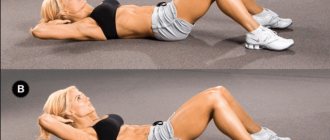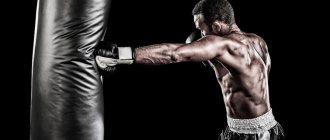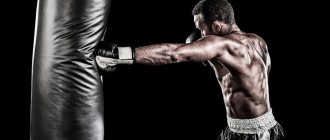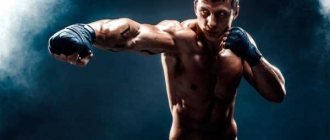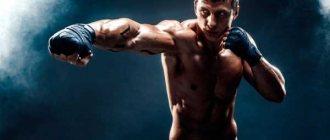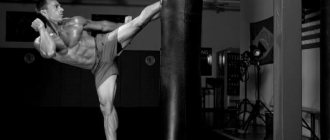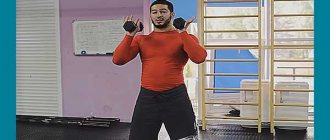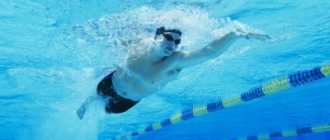Fists are the main tool in boxing and one of the most important in other martial arts. How lethal your blow will be depends on the strength and rigidity of your fist. A strong fist is the key to a future knockout. So now we'll learn how to make a punch look like a sledgehammer. And Nikko Fight Club coach Oleg Voloshko and world kickboxing champion Dmitry Polosenko will help us with this.
Dmitry (right) and Oleg
Punching a fist on a concrete wall
First of all, according to Dmitry Polosenko, we will need a concrete wall. For professionals, a bare wall will do, but amateurs should definitely start padding only on a “softened” wall, i.e. on a wall covered with a thin layer of felt.
“When we pump our fists, there is a rebound into the bone.”
World kickboxing champion and coach Dmitry Polosenko
Over time, the bone becomes harder and stops shaking violently when struck.
. Calluses form on the fist, which additionally protect the bone, but this, of course, looks extremely unaesthetic. Consequently, problems may arise when working delicately with your hands, and people, by looking at your hands, will already form their opinion about you. In fact, “punching” your fists on a concrete wall is not recommended for anyone, even professionals. All of the above was a lead-in to the topic of the difference in the effect of blows on the opponent’s body.
Boxer showing a full fist
Expert opinion
At one time I was involved in various sports: boxing and karate. And every time I began to comprehend the basics of any sport, I heard the same thing: “Fist stuffing.” Therefore, during my youth, I crushed about a whole truckload of bricks. But this did not make me invulnerable. Calluses on your knuckles are not cool. If any growths start to appear on your hands, this is a sign that the fighter is doing something wrong! And in this case, contact a mentor.
Russian athlete, Anatoly Pokhodsky
“Beating” fists and dying of nerve endings
As already mentioned, punching your fist on hard objects is highly undesirable. After all, each such blow crushes the joint capsule of the finger, which subsequently affects the health and integrity of the fist. How can you make your fist tougher? This requires not stuffing, but beating. Pounding involves killing the nerve endings of the striking surface of the fist with your own hands. This will help you not feel pain. Actually, we need nerve endings in order to prevent us from injury. Therefore, in order for the fist to become a real projectile, two things are needed: to strengthen the joints of the fingers, protecting them as much as possible from injury, and then to “kill” the nerve endings so as not to feel pain.
Muhammad Ali's fist. Knuckles covered with calluses to protect against shocks
What is padding and why is it needed?
Stuffing is a relatively long process, reminiscent of a Zen Buddhist procedure in its ceremonial monotony. If we add to this the masochistic tendency towards pain of the person producing it, then we can safely distinguish it as a special, unlike anything else spiritual practice. It has, however, a completely practical goal - to get a teeth-breaking fist.
In essence, padding is a procedural hardening of the striking surface: be it a fist, shin, head or even heel, allowing you to deliver and receive blows without pain, injury and damage to the connective tissues of the body, which, when struck with an unplanned force, risk turning into minced meat. Just as a guitarist’s fingers become calloused when playing for a long time, and the nerves move further away from the surface, allowing him not to feel pain when playing on hard strings, so when playing on hard strings, the bone structures are gradually transformed, the joints are strengthened and the skin is thickened, reducing pain. sensations when striking.
Recommended exercises to strengthen your fist
In order to strengthen the joint capsules of the future “projectile”, you need to focus on static exercises. These primarily include “lying emphasis” and push-ups. Push-ups should be of different types: on the fingers, on the fists, the usual type. This exercise also helps develop the trapezius muscles, triceps and pectoral muscles. These muscle groups are necessary to transmit the "attack energy" of the hitter. The best combination for strengthening your fists is to move from the prone position with fist push-ups to finger push-ups, then to regular push-ups, and so on.
. Thus, without padding, which cripples the hands, all joints of the fist are strengthened very easily and quite quickly.
Wladimir Klitschko does push-ups on two beating knuckles
Nutrition
A person is not always able to provide his body with the necessary micro and macroelements. With constant physical activity, an appropriate diet is necessary. Sports nutrition will help us with this; use supplements with the following content:
- Collagen.
- Glucosamine sulfate.
- Chondroitin sulfate.
By taking supplements containing these substances, you will perfectly strengthen and restore your joints and ligaments. Diversify your diet with different foods. The more there are, the better for the body.
Advanced Fist Strengthening Exercises
Having worked on the basic basis of fist stiffness, you should move on to more complex exercises. These include punching a punching bag, working with an expander and a powerball. An interesting exercise for strengthening your fist can be done at home: take a plastic bottle with flat walls, fill it with water and hang it on a rope. It should be lightly struck for 1-2 weeks. As soon as it becomes too easy to work “with water”, you can remove the bottle, pour out the water and fill the container with a bulk substance, such as cereal, sand or other material. A sort of improvised pear.
Another budget exercise for stuffing: a stack of newspapers, six to ten centimeters thick, is attached to the wall of the house. Every day you need to hit a stack of newspapers for about ten minutes, and after each workout, remove one sheet of paper. Exercises with makiwara will also be useful. Makiwara is a karate implement for practicing punches and kicks, if size allows. A homemade makiwara can be made at home; to do this, you need to take a sheet of wood about one and a half centimeters thick, and attach a soft horsehair base to one of the sides. In principle, any material will do, as long as it is soft.
. On makiwara you need to easily punch your fists with straight blows.
This is roughly what the simplest makiwara looks like. Rate it
( +1 points, 1 ratings)
Technical points to remember
A strong blow is formed not only due to high speed, but also due to its own weight. If you invest your full body weight, the result will be as powerful as possible. Avoiding dislocations is possible by following the correct execution technique, which involves never straightening the arm completely, and striking at different angles. They bring truly serious damage to the opponent.
Feet
They play no less a role in the impact force. Their position and movement must obey the following nuances:
- The feet must be placed wider than the shoulder girdle.
- The foot is turned in the direction of the movement made by the hand, while the heel is always raised first.
- When a blow is made with the right hand, the left foot does not move, the heel of the right one rises and vice versa.
Proper foot placement allows for much stronger and more powerful strikes, but is not the only thing to consider.
What else do you need to know to give your fist punch power?
- Keep your knees slightly bent, shifting your body weight forward.
- During the strike, the hips should turn in the direction in which the opponent is located.
- In close contact, full movement of the entire body allows you to increase the force of the blow.
- You can't reach forward. The body should turn sharply.
- Pulling the arm back during the swing allows the opponent to predict and prevent the strike.
- When striking, the fist must be clenched as tightly as possible.
- Each new blow is performed with an exhalation of air.
These requirements must be met not separately, but simultaneously.
Wall pillow, makivara
A boxing pillow is a projectile built into the wall for practicing a hard blow. It resembles a pear, but has a wooden base. Having bandaged your hands in advance, you are allowed to hit it with all your might, direct and side blows. It is important to remember that the force of action is equal to the force of reaction. An athlete, constantly working on it, may eventually complain of pain in the back and kidneys.
Makiwara is a fixed board covered with fabric. This simulator was invented in Japan for striking. Nowadays it has been modernized and has found wide application. This device is often found in boxing gyms.
We have looked at the most common ways to properly fill your hands. Train, strengthen your body and spirit. I hope you got a lot of interesting information from my article. I wish you success and health.
Do I need to learn different strike forms?
We’ll answer right away: yes! Moreover, any type of martial arts is a complex that is learned by the body in practice and brought to the point of automatism, a reflex! Learning one punch and defeating opponents in and out of the ring is a myth. This is impossible to imagine.
Even if you choose several strikes as your base (and this will need to be done, we have given one of the strikes only for illustration, example): straight, hook and some kind of uppercut - hone them in training and learn how to hit the enemy’s vulnerable points, that’s all there will still be no guarantee that you will emerge victorious from a fight even one on one. Everything can depend on chance and chance.
Perhaps you have not paid enough attention to training to repel an attack; perhaps your stance is incorrect (forearms and elbows do not protect your torso and it is easy to penetrate). But you never know - your friends have arrived to help your opponent... There are many nuances. Just one example of competent motor skills:
if your chin is down and the punch goes straight, the shoulder will automatically rise and protect your chin even more.
Warm-up
Fingers, like other parts of the body, can be injured and need to be warmed up and prepared for training.
- Clench and unclench your fists for a few seconds
- Extend your arms in front of you. Try to spread your straightened fingers as far apart as possible. Then press your fingers as close as possible to each other. This exercise will bring you closer to gaining the ability to pick up the ball.
- Rotate your hands in your fists
What's the point
What is the main point and how to properly fill your fists at home. There are many options for special exercises aimed at consciously provoking micro-tears of connective and cartilage tissues. The subsequent healing of which strengthens the tissues of bones and joints. Due to this, the hardness of the wrist joint increases and the pain threshold decreases. When stuffing, it is important not to injure your hand. Training should take place in stages with a gradual increase in load. You should know that the process itself takes time, so you should not expect results to be achieved in a couple of weeks. You can stuff not only your arms, but also your legs for low kicks and high kicks.
The following exercises are useful because:
- reduce the pain threshold;
- make the skin rougher;
- compact the bone structure;
- makes joints stronger.
Working with the bag
A punching bag is the best option for punching your fists. An inexperienced athlete needs to be careful with this equipment. Before starting classes, a boxer must understand the technical aspect of striking; it is practiced in front of a mirror, in a training and combat stance. Afterwards, switch to the projectile. The bag breaks the blow. Even after mastering the technical part, you need to hit the bag carefully. The arm at the time of application must be straight, from the hand to the elbow joint, otherwise the ligaments will stretch. You need to hit 30%-40% of your maximum force. The fist must rest on the pear at an angle of exactly 90 degrees, otherwise the skin on your fingers will bleed and you will fall out of the learning process for 1-2 weeks.
Strong is not the one who wins a fight, but the one who was able to prevent it
From this we conclude: the basics of self-defense in hand-to-hand combat are necessary, but they should be used in exceptional circumstances. It's better to prevent a fight by negotiating or just walking away. If you can't avoid it, run. Even if you are 1,000% right, if something happens to your counterpart in a fight, you will be responsible if the court considers that the limits of self-defense were exceeded. Well, or you can become a victim. It will be a shame to receive a disability when the problems could have been avoided.
PS If you live in an area with a bad crime situation, make it a rule to carry a spray can with you for self-defense. It will be difficult for even a good karateka or boxer to resist him! But you also need to know how to use a spray can...
Cover: unsplash.com / Dan Burton
*4. Direct strike or which strike should a beginner choose as his main one?
photo: unsplash.com / Alexander Jawfox
Perhaps the most understandable type of blow, familiar to every person since childhood, is a direct blow. It is not for nothing that this natural throw of the hand is present in, perhaps, any fighting system: boxing, karate, Mau Thai and others.
Therefore, the answer to the question of choosing a blow with which to start learning is obvious - it’s a straight blow !
Where should you aim?
Since you want the fight to end as quickly as possible, you will try to incapacitate your opponent as quickly and efficiently as possible so that you can run away (yes, one of the best strategies in a dangerous situation) and call the police.
As tempting as it may be to punch your opponent in the face, Horan says it's the wrong move:
“You'll either miss or usually hit it wrong and break your fingers. For beginners, it is best to strike a blow to the body, to the chest or side, for example, to the ribs,” he notes.
By the way, remember that it is impossible or not recommended to hit some parts of the body - for example, in the throat, hard in the nose, in the heart area... If the blow is serious, a person may die from it. But who, in the heat of battle, will think about such “little things”! But in vain, because you shouldn’t forget about article number 114 of the Criminal Code of the Russian Federation. “Inflicting serious or moderate harm to health when exceeding the limits of necessary defense...”
1. Intentional infliction of grievous bodily harm, committed when exceeding the limits of necessary defense, -
shall be punishable by correctional labor for a term of up to one year, or restriction of freedom for a term of up to one year, or forced labor for a term of up to one year, or imprisonment for the same term.
Or even more serious - Article 108 of the same Criminal Code, if a murder occurred when the limits of necessary defense were exceeded.
Motivation
Many boys in childhood, wanting to be strong, punched their fists against fences, walls, heavy bags, etc. They were inspired by the successes of Eastern masters. Only often this ended in serious injuries to the hands and fingers.
The motivation to be stronger and have powerful fists should not contradict common sense. And you need to approach this task systematically and plan your lesson schedule, identify all your shortcomings and develop a plan to eliminate them.

